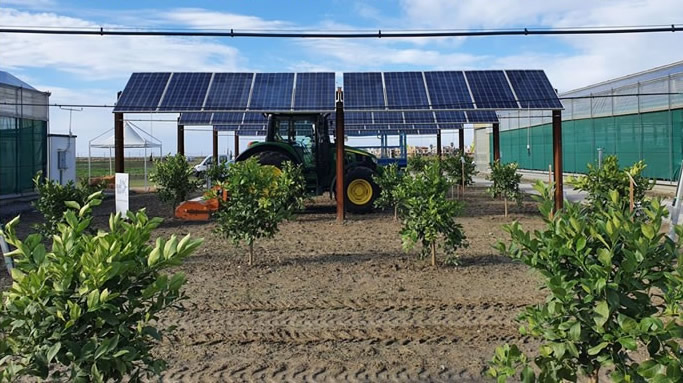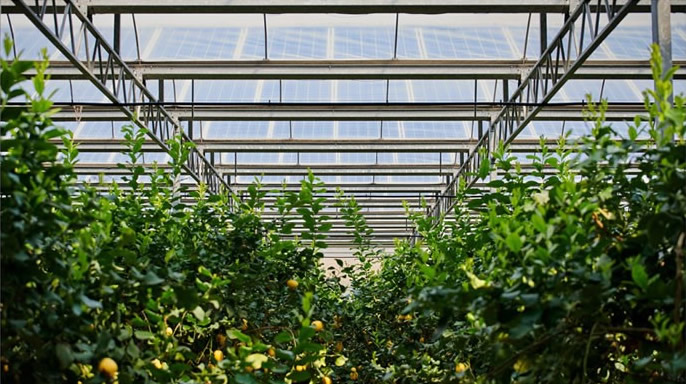A new frontier for Agrivoltaics: the launch of the SYMBIOSYST project

Facing the ambitious target of reaching net-zero emissions by 2050, European societies need all the tools and viable solutions to increase the share of clean energy production, without causing additional environmental impact. A remarkable opportunity is offered by combining in a smart way what we already have today, agricultural activity and solar energy production from photovoltaic (PV) panels.
The concept of agrivoltaics, also called agri-PV or agro-PV, makes dual use of land for agriculture and solar energy generation, and it is one of the research fields that has been emerging in recent years with a large variety of novel agri-PV systems.
The SYMBIOSYST project is an Innovation Action funded by the Horizon Europe programme (Grant Agreement N. 101096352), starting in January 2023 with the aim to combine energy supply issues with the needs of the agricultural sector as well as creating a symbiosis where PV and agriculture can have a mutually beneficial relationship.
The project will develop technological solutions and strategies to increase the competitiveness of agri-PV solutions across Europe minimizing the impact on landscape and surrounding environments. Another aim is to foster social acceptance and interest for agri-PV solutions and to encourage further investments.

Considering the lessons from past mistakes which delayed the implementation of cost-effective solutions in the integrated PV sector and market acceptance, SYMBIOSYST is focused on the development of standardized cost-effective solutions in terms of PV modules, mounting structures and Operation and Maintenance practices to the specific needs of various crops in different climates and landscapes.
The project will demonstrate the developed products and services through the set up and activation of a network of agri-PV plant demonstrators and the application, with in-field testing of the innovative solutions studied, in four agricultural scenarios differing in location, climate, size, and kind of crops.
The interdisciplinary consortium in SYMBIOSYST is composed of partners across the value chain with decades of experience in agriculture, precision farming, technology, social acceptance and participatory method, PV modules and systems, integrated PV applications such as BIPV and agri-PV.
In SYMBIOSYST, ETA Florence will manage communication and disseminations activities by reaching target audiences through knowledge transfer of the projects potential and its achievements. More specifically ETA Florence aims to: provide the project with a fully-fledged and unique visual identity on and off-line; action a wide range of communication and dissemination activities to raise public awareness of the research; effectively disseminate the project outcomes to stakeholders, scientific communities and policy makers; establish connections with and among other complementary projects and initiatives to set the foundations of a new and effective European Community for Sustainable Agrivoltaics, as already supported by ETA Florence in Italy.
The consortium is coordinated by Eurac Research (Italy). Other partners are: Interuniversitair Micro-Electronica Centrum - IMEC (Belgium), Technische Universiteit Delft (Netherlands), Agenzia Nazionale per le Nuove Tecnologie, l’Energia e lo Sviluppo Economico Sostenibile - ENEA (Italy), Aleo Solar GmbH (Deutschland), KU Leuven (Belgium), Centro di Sperimentazione Laimburg (Italy), Südtiroler Bauernbund (Italy), ETA Florence - Renewable Energies (Italy), Universitat Politecnica de Catalunya (Spain), Physee Products B.V. (Netherlands), Kubo Innovations BV (Netherlands), Convert Italia SPA (Italy), Lucisun (Belgium), 3E (Belgium), Belgisch Laboratorium Van Elektriciteitsindustrie (Belgium), EF Solare Italia SPA (italy). As an affiliated partner there is: Above Surveying LTD (United Kingdom).
Comments (0)
This post does not have any comments. Be the first to leave a comment below.
Featured Product

